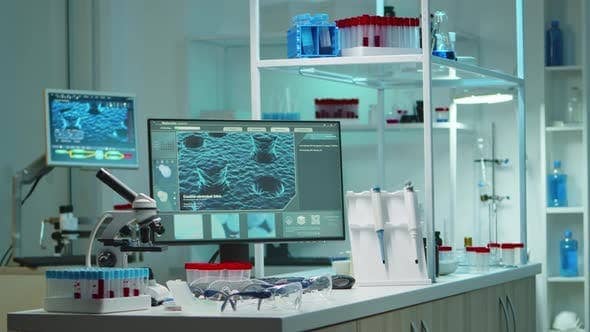The incandescent tube lights flickered momentarily and soon the massive expanse illuminated, revealing its contents. The familiar fourteen black marble tables were arranged into a composite grid of two rows and seven columns echoing a quartz-like cubic lattice. Cream coloured, circular stools shadowed the platforms and sent a stinging pain in my back just by their mere appearance. The off-white brick walls were lined with rusty, decrepit crimson cabinets clearly in dire need of being replaced. Turning 180 degrees from the platforms was the bare blackboard with “Texas Biomedical Research Institute” written in bold, yellow, familiar letters right at the top. It was followed by white chalky circular wipes, augmented by the black background. The deafening eerie silence in the laboratory was interrupted by a raucous thunder awakening the night. Unlike the usual bustle and chatter of my lab mates and the clinking of glass apparatus in the morning, all one could hear was the rhythmic pitter-patter of the rain in coordination with the clock ticking away…..
The laboratory always reeked of an amalgam of sour and acrid chemicals, but unlike before, one pungent odour was vividly distinguishable. This toxic scent seemed to waft from one of the tables cluttered with borosil apparatus. A bottle of hydrofluoric acid was left open which smelled like sushi just a few days out of date. It was the only bottle that was missing from the chemical cabinet which consisted of a plethora of different alkalis and bases. Putting the bottle back into the cabinet felt oddly satisfying, as if joining together the last jigsaw puzzle piece to view the meticulous and striking result. The bottle blended in with the rest of chemicals, completing their aesthetically pleasing pattern, formed due to stacking the containers colour wise, right from the darkest shade of merlot red to the lightest hue of thistle violet.
Alongside the cabinet was an array of instruments including beakers, test tubes, distillation flasks, conical cylinders and petri dishes that were scattered across the marble platform, morphing into a jungle formed by pellucid glass. The silhouetted shadows of the apparatus seemed to be stirring to life as they shifted places, carrying out their own “experiment” due to the movement of the diffused light source, being the vehicles’ headlights. Running my hand along the cold, smooth surface of the apparatus, the slightest coarse bumps formed due to the minuscule graduations were lucidly distinct. Beside the instruments, lay the sooty steel sink and faucet accommodated at every table, with the scrawny taps hovering over the cavities like silver slithering snakes.
Coordinating with the ash basins, were the newest addition to the lab, fourteen 27-inch computers with a spectacular 4.5 K retina display. Their surfaces were as lustrous as copper sulphate crystals with a tinge of rich livid. Pressing the obsidian engraved power button, a sense of nostalgia flooded me as the eternal tune of Windows XP start-up chimed. Clicking on the first folder, stimulated a slideshow of various snapshots of the very room I was standing in, except the refracting rays of sunlight illuminated the institute, entering through the lucent windows. It was daytime. I could almost hear the photos, the sizzle of sodium bicarbonate and acetic acid, the squeaky pop of hydrogen testing and the unmistakable chortle of people, zestful as an electron, in itchy white lab coats. One of the pictures featured our 3D molecular model, now no longer discernible due to a clumsy misfortune. I yearnfully contemplated the trimethylamine molecule model, the grey diminutive spheres, coherently linked to heftier blue and black atoms, forming a covalent bond.
Another snapshot zoomed into the varied charts and graphs displayed on the indigo soft board secured tight with scarlet red pins piercing right into the velveteen flesh. The crisp colour coordinated papers presented an array of polymer molecular arrangements, always a go-to while anxiously attempting to recall a polyamide structure. Surrounding them were the magnified images of the epidermis cell, tinted with methylene blue highlighting their organelles and charts of honeycomb-like tessellating hexagons of alum crystals. Though, with the advent of technology, these charts were just in our mere memory. Digital files and documents overwrote any physical traces of handmade charts and scraped the walls and boards bare, exposing its distinct, fresh skin in the form of rectangles in contrast with the surrounding oxidised region of the walls. This made me reflect on the fact that how the same conventional content can seem unusual when presented with different settings. The laboratory at night whereas during the day, or the same erstwhile, before digitalization, contrasting with the modern, sophisticated environment I see now. I pondered on this thought as I hung the coarse white coat on the tarnished peg and walked out into the pluvious night….
Featured Image Courtesy: https://videohive.net/item/interior-of-empty-science-laboratory-during-night/29800725

